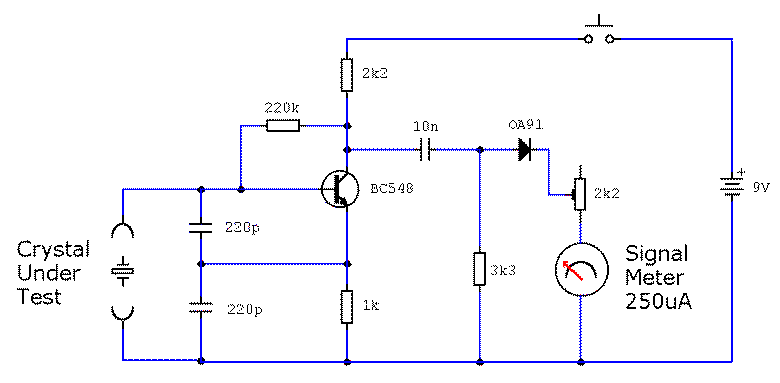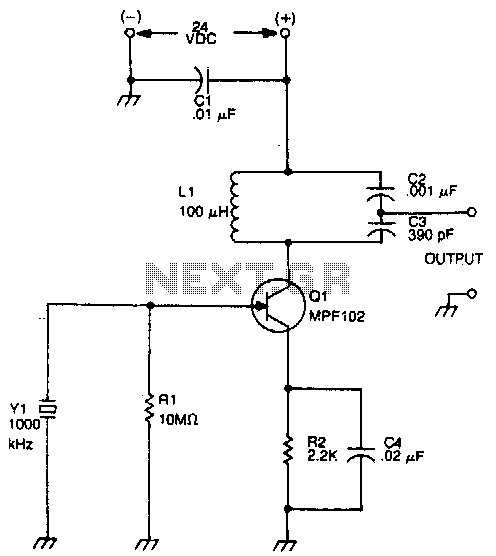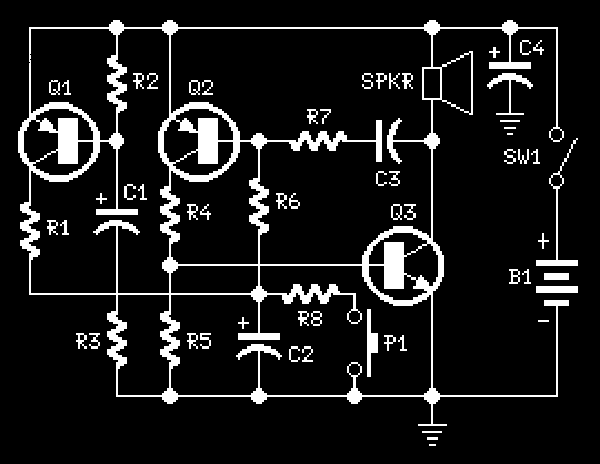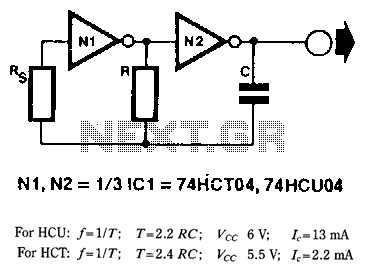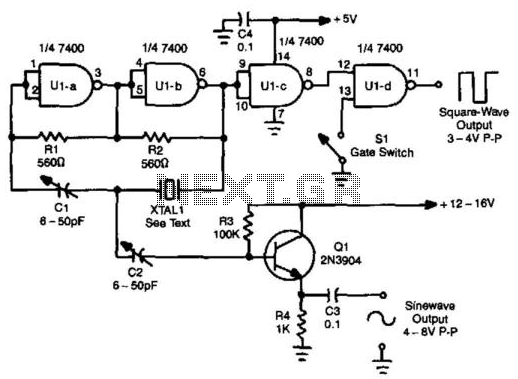
oscillator circuits
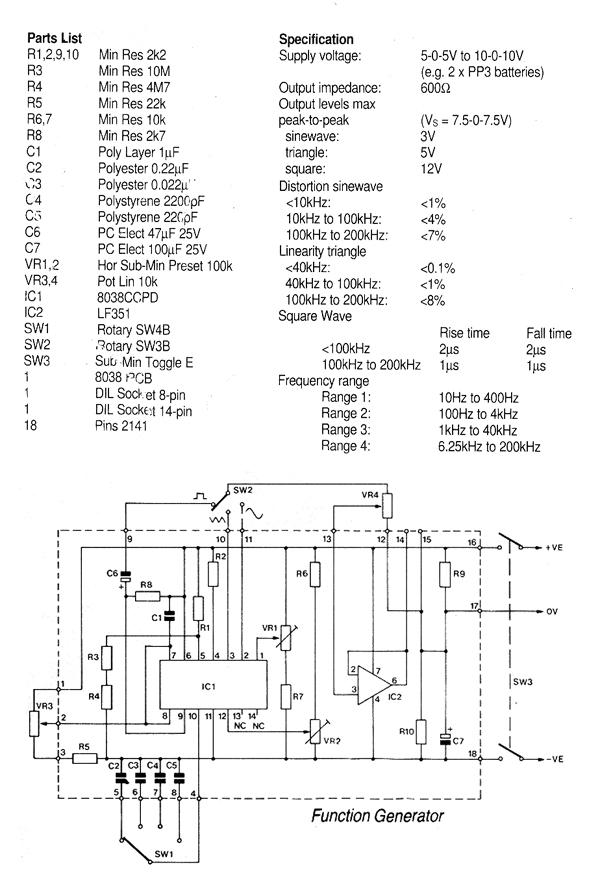
This generally results in a square wave if the frequency of oscillation is low enough relative to the amplifier's bandwidth. The schematic of a crystal-controlled oscillator features a low-frequency sine wave oscillator characterized by low distortion, wideband operation, and crystal control. Originally developed for laboratory use, the circuit employs low-cost AF bipolar transistors for the oscillator and amplifier sections, and a JFET for loop-gain control. The oscillator operates effectively in the 10 kHz to 500 kHz frequency range, with measured distortion kept under 0.1 percent. DTMF generation utilizes a 3.58 MHz crystal, consisting of selecting and combining two audio tone frequencies associated with the rows (low band frequency) and columns (high band frequency) of a pushbutton touch tone telephone keypad. A function generator using the ICL8038 integrated circuit has four ranges and is capable of producing sine, square, and triangle outputs. The ICL8038 waveform generator is a monolithic integrated circuit capable of producing high-accuracy sine, square, triangular, sawtooth, and pulse waveforms with minimal external components. A simple test circuit, known as a signal injector and tracer, is used to fault-find audio and radio equipment. It can inject a square wave signal rich in harmonics or be used with headphones as an audio tracer. Additionally, the ICL8038 VCO (voltage-controlled oscillator) chip allows for frequency ranges from less than 1 Hz to over 100 kHz, providing high output power (greater than 1A) for the sine output, suitable for driving inductive loads, with some protection against damage. The CMOS-compatible complementary square wave output is designed for digital circuit clocking and can drive into a 50 Ohm load.
The described circuit incorporates several key components and functionalities that enhance its versatility and performance in various applications. The crystal-controlled oscillator operates within a specific frequency range, ensuring stability and precision in frequency generation. The use of AF bipolar transistors allows for effective amplification while maintaining low distortion levels, making it suitable for high-fidelity audio applications.
The DTMF generation feature is particularly noteworthy, as it allows for the synthesis of dual-tone multi-frequency signals that are essential in telecommunications. By combining specific frequencies associated with the keypad layout, the circuit can accurately replicate the tones used in touch-tone dialing systems.
The ICL8038 integrated circuit serves as a multifunctional waveform generator, providing a wide array of output waveforms with minimal external components. Its ability to produce sine, square, triangular, sawtooth, and pulse waveforms makes it an invaluable tool in signal processing and testing environments. The four output ranges further enhance its usability in various scenarios, from low-frequency applications to high-frequency testing.
The signal injector and tracer circuit is designed for troubleshooting audio and radio equipment, allowing technicians to inject test signals and trace audio paths with ease. This functionality is critical in diagnosing faults and ensuring the reliability of audio systems.
Overall, the combination of these elements within the circuit design creates a robust platform for generating and manipulating various waveforms, making it suitable for laboratory applications, telecommunications, and audio engineering. The design emphasizes low distortion, high accuracy, and versatility, ensuring that it meets the demands of modern electronic applications.This generally results in a square wave if the frequency of oscillation is low enough relative to the amplifier`s bandwidth Crystal Controlled Oscillator schematic of a low frequency sine wave oscillator featuring low distortion, wideband operation and crystal control. The circuit, originally dev eloped for laboratory use, employs low cost AF bipolar transistors for the oscillator and amplifier sections and a JFET for loop-gain control. Operation of the oscillator in the 10 kHz to 500 kHz frequency range has been found to be excellent, while measured distortion is kept under 0.
1 percent DTMF Generation with a 3. 58 MHz Crystal DTMF generation consists of selecting and combining two audio tone frequencies associated with the rows (low band frequency) and columns (high band frequency) of a pushbutton touch tone telephone keypad, PDF Function Generator A function generator using the ICL8038 integrated circuit. Is has four ranges and capable of sine, square and triangle outputs, ICL8038 The ICL8038 waveform generator is a monolithic integrated circuit capable of producing high accuracy sine, square, triangular, sawtooth and pulse waveforms with a minimum of external components.
Signal Injector and Tracer A simple test circuit to fault find audio and radio equipment. Can be used to inject a square wave signal, rich in harmonics, or used with headphones as an audio tracer, schematics Simple Sine, Triangle and Square Wave Generator Intersil`s ICL8038, VCO (voltage controlled oscillator) chip, Frequency range <1Hz to >100kHz, High output power (>1A) for the sine output (e. g. to drive inductivities) with some protection against destruction, CMOS-compatible complementary square wave output for digital circuit clocking (can drive into 50 Ohm)
🔗 External reference
The described circuit incorporates several key components and functionalities that enhance its versatility and performance in various applications. The crystal-controlled oscillator operates within a specific frequency range, ensuring stability and precision in frequency generation. The use of AF bipolar transistors allows for effective amplification while maintaining low distortion levels, making it suitable for high-fidelity audio applications.
The DTMF generation feature is particularly noteworthy, as it allows for the synthesis of dual-tone multi-frequency signals that are essential in telecommunications. By combining specific frequencies associated with the keypad layout, the circuit can accurately replicate the tones used in touch-tone dialing systems.
The ICL8038 integrated circuit serves as a multifunctional waveform generator, providing a wide array of output waveforms with minimal external components. Its ability to produce sine, square, triangular, sawtooth, and pulse waveforms makes it an invaluable tool in signal processing and testing environments. The four output ranges further enhance its usability in various scenarios, from low-frequency applications to high-frequency testing.
The signal injector and tracer circuit is designed for troubleshooting audio and radio equipment, allowing technicians to inject test signals and trace audio paths with ease. This functionality is critical in diagnosing faults and ensuring the reliability of audio systems.
Overall, the combination of these elements within the circuit design creates a robust platform for generating and manipulating various waveforms, making it suitable for laboratory applications, telecommunications, and audio engineering. The design emphasizes low distortion, high accuracy, and versatility, ensuring that it meets the demands of modern electronic applications.This generally results in a square wave if the frequency of oscillation is low enough relative to the amplifier`s bandwidth Crystal Controlled Oscillator schematic of a low frequency sine wave oscillator featuring low distortion, wideband operation and crystal control. The circuit, originally dev eloped for laboratory use, employs low cost AF bipolar transistors for the oscillator and amplifier sections and a JFET for loop-gain control. Operation of the oscillator in the 10 kHz to 500 kHz frequency range has been found to be excellent, while measured distortion is kept under 0.
1 percent DTMF Generation with a 3. 58 MHz Crystal DTMF generation consists of selecting and combining two audio tone frequencies associated with the rows (low band frequency) and columns (high band frequency) of a pushbutton touch tone telephone keypad, PDF Function Generator A function generator using the ICL8038 integrated circuit. Is has four ranges and capable of sine, square and triangle outputs, ICL8038 The ICL8038 waveform generator is a monolithic integrated circuit capable of producing high accuracy sine, square, triangular, sawtooth and pulse waveforms with a minimum of external components.
Signal Injector and Tracer A simple test circuit to fault find audio and radio equipment. Can be used to inject a square wave signal, rich in harmonics, or used with headphones as an audio tracer, schematics Simple Sine, Triangle and Square Wave Generator Intersil`s ICL8038, VCO (voltage controlled oscillator) chip, Frequency range <1Hz to >100kHz, High output power (>1A) for the sine output (e. g. to drive inductivities) with some protection against destruction, CMOS-compatible complementary square wave output for digital circuit clocking (can drive into 50 Ohm)
🔗 External reference
